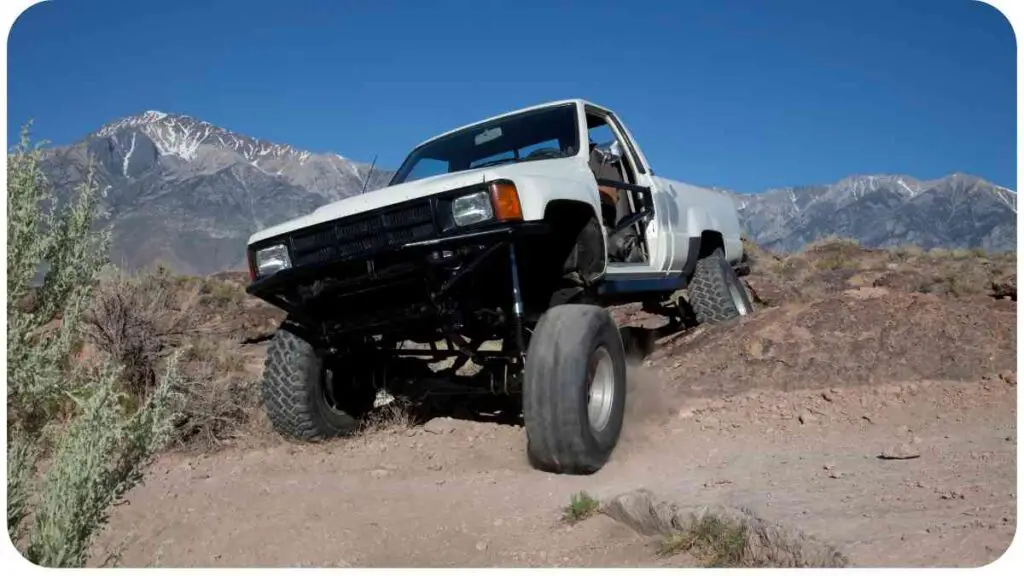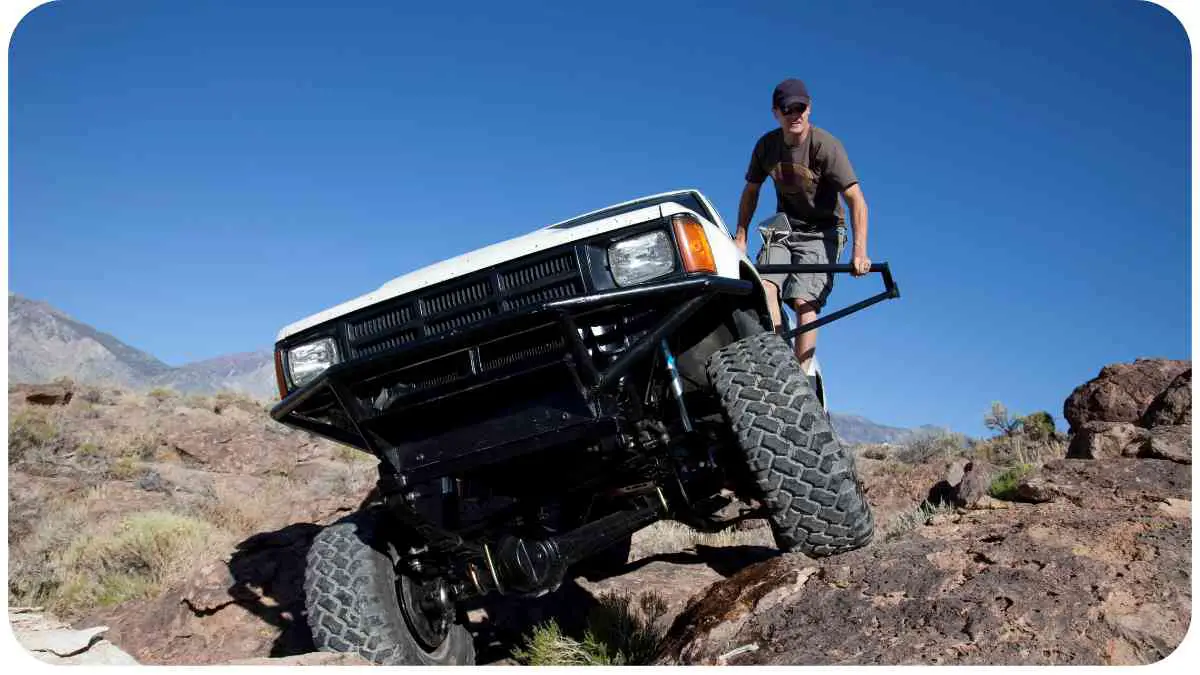Welcome to this comprehensive guide on how to adjust the shocks on your off-road vehicle. Off-roading is an exhilarating activity that pushes both driver and machine to their limits. To fully enjoy your off-road adventures, it’s crucial to ensure your vehicle’s suspension is properly set up.
In this article, we will cover the importance of adjusting your shocks and provide you with step-by-step instructions to optimize your off-road vehicle’s shock performance. So let’s dive in and learn how to make those necessary adjustments for an improved off-roading experience!
| Takeaways |
|---|
| Adjusting shocks is crucial for optimizing off-road vehicle performance. |
| Rebound dampening controls the rate at which the suspension extends after compressing. |
| Compression dampening regulates how the shocks absorb compression forces. |
| Preload adjustment helps achieve proper ride height and responsiveness. |
| Regular cleaning and inspection ensure the longevity and functionality of off-road shocks. |
| Timely replacement of damaged components is essential for maintaining optimal performance. |
| Consulting manufacturer instructions and guidelines is important for accurate adjustment. |
| It’s recommended to find a balance between comfort and performance when tuning shocks. |
| Understanding the specific terrain and load conditions is important for fine-tuning adjustments. |
| Professional help or assistance should be sought if unsure or uncomfortable with DIY adjustments. |
2. Understanding Off-Road Shocks
Off-road shocks, also known as shock absorbers, play a vital role in maintaining vehicle stability and control while navigating challenging terrains. These specialized components dampen the impact of bumps, jumps, and vibrations, keeping your wheels in contact with the ground for better traction and control. Off-road shocks are designed to handle the demanding conditions encountered in off-road environments, providing enhanced performance and comfort.
When it comes to improving your off-road vehicle’s performance, consider upgrading the suspension. Upgrading the suspension can significantly impact your off-road adventures, providing a smoother and more controlled ride on challenging terrains.
3. Why Adjusting Your Shocks Matters

Adjusting your shocks is a critical step in optimizing your off-road vehicle’s suspension system. Let’s explore the reasons why shock adjustment matters:
3.1 Improved Performance and Comfort
By adjusting your shocks, you can fine-tune the suspension to suit your specific off-road driving style and terrain. You can enhance performance by ensuring your vehicle maintains better stability, reduced body roll, and improved handling. With properly adjusted shocks, you can navigate uneven surfaces, ruts, and obstacles more effectively, gaining better control and reducing unnecessary wear and tear on your vehicle.
3.2 Enhanced Safety
Off-road driving can be unpredictable, and having shocks set up correctly can greatly enhance your safety. Improved suspension performance translates into better stability during sudden maneuvers, minimizing the risk of rollovers and loss of control. When your vehicle is properly adjusted for off-road conditions, you can enjoy a safer and more enjoyable off-road experience.
Off-road enthusiasts often encounter suspension problems during their adventures. It’s crucial to understand common suspension issues and how to fix them, ensuring a safe and enjoyable off-roading experience.
4. Tools Required for Shock Adjustment

Before you start adjusting your shocks, ensure you have the following tools ready:
4.1 Shock Absorber Spanner Wrench
A shock absorber spanner wrench is a specialized tool used to adjust the pre-load and other settings on your shocks. Different shocks may require different types of spanner wrenches, so make sure you have the correct one for your specific shocks.
4.2 Hydraulic Floor Jack
A hydraulic floor jack is essential for lifting your off-road vehicle, allowing you to access the suspension components easily. Choose a floor jack capable of lifting your vehicle’s weight with ease, ensuring your safety during the adjustment process.
Differentials play a significant role in off-roading, affecting the vehicle’s performance on uneven terrain. Understanding the role of differentials is crucial for making informed decisions when modifying your off-road vehicle.
4.3 Socket Set
A socket set with various metric and standard socket sizes will be necessary to remove any components obstructing the shock adjustment process. It’s essential to have a well-stocked socket set to work efficiently and avoid delays.
Now that we have covered the necessary tools, let’s move on to the next section, where we will discuss checking suspension travel and its importance.
5. Checking Suspension Travel
Suspension travel refers to the distance a wheel can move up and down within the suspension’s range of motion. It is crucial to check suspension travel before adjusting your shocks to ensure they are functioning optimally. Here’s how you can inspect and measure your suspension travel:
5.1 Understanding Suspension Travel
Start by parking your vehicle on a level surface and jacking up one corner using the hydraulic floor jack. Make sure to place jack stands beneath the frame to ensure stability and safety. With the wheel off the ground, you can now determine the suspension travel by pushing gently down on the vehicle’s bumper and watching the movement of the wheel.
While adjusting shocks is essential for off-road performance, it’s also important to understand ATV battery life. Knowing how to preserve and extend your ATV’s battery life ensures reliability during your off-road adventures.
5.2 Inspecting for Maximum Extension
During the suspension travel test, keep an eye out for any signs of binding or restricted movement. If the wheel does not articulate smoothly or feels excessively stiff, there may be an issue with the shocks or other suspension components that need attention.
6. Adjusting Rebound Dampening
Rebound dampening refers to the shock’s ability to control the rate at which the suspension extends after compressing. It influences the speed at which the wheel returns to its original position. Adjusting rebound dampening allows you to fine-tune the shock’s response to various terrain conditions. Here’s how to set the rebound dampening correctly:
6.1 What is Rebound Dampening?
Rebound dampening prevents the suspension from bouncing back too quickly after it compresses. If the rebound is too fast, it can cause the vehicle to become unstable and lose traction. Conversely, if the rebound is too slow, the suspension might not return to its proper position in time, affecting the vehicle’s handling and overall performance.
6.2 Setting Rebound Dampening
To adjust rebound dampening, locate the rebound adjustment knob on your shock. It’s typically found at the top of the shock body. With the shock absorber spanner wrench, turn the knob clockwise to increase rebound dampening or counterclockwise to decrease it. Start with the manufacturer’s recommended settings and fine-tune it based on your preferences and the terrain conditions you expect to encounter.
It’s essential to test your vehicle’s performance after each adjustment. Take it for a short drive over various terrain types and assess how the shocks respond. Make incremental changes until you find the optimal setting for your off-roading needs.
Now that you have a clearer understanding of rebound dampening adjustment, let’s move on to adjusting compression dampening.
7. Adjusting Compression Dampening
Compression dampening controls the shock’s ability to absorb and dampen the compression forces generated when the suspension compresses. It impacts how the vehicle reacts to bumps, jumps, and other impacts encountered during off-road driving. Let’s delve into how you can adjust the compression dampening of your shocks:
7.1 What is Compression Dampening?
Compression dampening regulates the rate at which the shock absorbs compression forces. If the compression dampening is too soft, the shock will compress too quickly, resulting in a harsh and bumpy ride. On the other hand, if it’s too stiff, the shock won’t compress enough, causing the vehicle to bounce or lose traction when encountering obstacles.
7.2 Setting Compression Dampening
Locate the compression adjustment knob on your shocks, usually positioned near the bottom of the shock body. Use the shock absorber spanner wrench to turn the knob clockwise to increase compression dampening or counterclockwise to decrease it.
It’s crucial to find a balance between firmness and suppleness. You want the suspension to absorb impacts and maintain control without compromising overall ride quality. Start with the manufacturer’s recommended settings and fine-tune based on your personal preferences and the terrain conditions you anticipate.
Regularly test your vehicle after adjustments by driving over various surfaces and observing how the shocks respond. Make gradual changes until you find the ideal compression dampening setting for your off-road adventures.
Now that you have adjusted your rebound and compression dampening, let’s discuss the importance of ensuring proper preload.
8. Ensuring Proper Preload
Preload refers to the amount of initial tension applied to the shock absorber’s springs. Proper preload adjustment ensures that the suspension is balanced and provides consistent performance. Let’s dive into understanding preload and how to adjust it correctly:
8.1 What is Preload?
Preload is the force applied to the springs when the suspension is at its resting position. It affects the ride height and sag of the vehicle, as well as the overall responsiveness of the shocks. Adjusting preload allows you to fine-tune the suspension for different load conditions and terrain types.
8.2 Adjusting Preload
To adjust preload, consult your vehicle’s owner’s manual or the shock manufacturer’s instructions for the recommended procedure and specifications. In most cases, you will need to use the shock absorber spanner wrench to adjust the preload collars on the shock body. Turning the collars clockwise increases preload, while turning them counterclockwise decreases preload.
It’s essential to strike a balance between too much preload, which may result in a harsh ride, and too little preload, which can cause excessive suspension sag and reduced stability. Follow the manufacturer’s guidelines and make small adjustments, testing the vehicle’s performance after each change. Focus on achieving the appropriate ride height and maintaining consistent handling characteristics.
Properly adjusted preload ensures that your vehicle’s suspension responds optimally to various off-road conditions, providing you with the desired balance between comfort and performance.
Remember to always refer to the manufacturer’s instructions and recommendations specific to your vehicle and shocks. Now, let’s move on to discussing some essential maintenance tips for off-road shocks.
9. Maintenance Tips for Off-Road Shocks
Proper maintenance of your off-road shocks is crucial to ensure their longevity and optimum performance. Regular cleaning and inspection, as well as timely replacements, are essential to keep your shocks in top condition. Let’s explore some important maintenance tips for off-road shocks:
9.1 Regular Cleaning and Inspection
Off-road driving exposes your shocks to dirt, mud, and other contaminants that can affect their performance. It’s important to regularly clean your shocks to remove any built-up debris that could hinder their operation. Use a gentle brush or cloth to wipe away dirt and grime from the shock body and components. Avoid using high-pressure water as it can damage seals.
Along with cleaning, inspect your shocks for any signs of leaks, damage, or worn-out components. Check for oil leaks, loose mounting bolts, and any visible wear on the shock body and bushings. Additionally, ensure that the adjustment knobs are functioning properly and not damaged. Any issues found during the inspection should be addressed promptly.
9.2 Replacing Damaged Components
If you notice any significant damage or wear during the inspection, it’s important to replace the damaged components. Worn-out bushings, damaged seals, or leaking shocks can compromise their performance and safety. Consult with a professional or refer to the shock manufacturer’s guidelines for proper replacement procedures and compatible parts.
Regularly replacing worn-out components and keeping your shocks in good condition will ensure they continue to perform optimally and provide you with a smooth and controlled off-road experience.
Now that we have covered the maintenance tips for off-road shocks, let’s move on to the conclusion of our comprehensive guide.
10. Conclusion
Adjusting and maintaining your off-road shocks is crucial for maximizing the performance, comfort, and safety of your off-road vehicle. By understanding the functions of rebound dampening, compression dampening, and preload, you can fine-tune your shocks to suit your driving style and the specific terrain you’ll encounter.
Remember to use the appropriate tools for shock adjustment, such as a shock absorber spanner wrench, hydraulic floor jack, and socket set. Regularly inspect and clean your shocks to ensure they are in good condition, and promptly address any issues that arise.
By following the steps outlined in this guide and consulting the manufacturer’s recommendations, you can optimize your off-road vehicle’s suspension and enjoy a safer and more enjoyable off-roading experience. So go ahead, make those adjustments, and hit the trails with confidence!
Remember to always consult your vehicle’s owner’s manual and follow the manufacturer’s guidelines for any specific instructions related to your vehicle and shocks.
Further Reading
Here are some additional resources where you can find more information on adjusting shocks for off-road vehicles:
- Can-Am Off-Road – How to Adjust SxS Shocks: This article from Can-Am provides step-by-step instructions and helpful tips for adjusting shocks on side-by-side (SxS) vehicles.
- SuperATV – How to Adjust ATV Shocks: SuperATV’s guide offers detailed instructions and explanations on adjusting shocks specifically for ATVs (All-Terrain Vehicles).
- We Air Down – How to Tune Off-Road Suspension: This post on We Air Down blog provides insights into tuning off-road suspension, including shock adjustments, to achieve optimal performance and comfort.
FAQs
Here are some frequently asked questions about adjusting shocks for off-road vehicles:
How often should I adjust my off-road shocks?
The frequency of adjusting your off-road shocks depends on your driving habits, terrain conditions, and personal preferences. It’s recommended to assess and adjust your shocks periodically, such as at the beginning of each off-road season or after any significant changes to your vehicle or driving style.
Can I adjust my shocks without any specialized tools?
While basic adjustments like rebound and compression dampening can be made with a shock absorber spanner wrench, more advanced adjustments and fine-tuning may require specialized tools. It’s best to have the recommended tools and follow the manufacturer’s instructions for optimal results.
What signs indicate that my shocks need adjustment?
Signs that your shocks may need adjustment include excessive bouncing, poor vehicle stability, bottoming out, or an uncomfortable ride. Additionally, if you switch between different terrains frequently, adjusting your shocks can help optimize performance for each specific environment.
Is adjusting shocks a DIY task, or should I seek professional help?
Basic shock adjustments can often be done by DIY enthusiasts who have the necessary tools and instructions. However, if you are unsure or uncomfortable performing the adjustments yourself, it’s always advisable to consult a professional or seek assistance from an experienced technician.
Are shock adjustments the only aspect of off-road suspension tuning?
No, shocks adjustments are just one part of off-road suspension tuning. Other factors such as tire pressure, alignment, and sway bars also play important roles in achieving optimal off-road performance. It’s recommended to consider the overall suspension setup and take a balanced approach when tuning your off-road vehicle’s suspension system.

Hi there! I’m Hellen James, and I’m the author of Unified Off-roads. I’ve been driving off-road for more than ten years, and I’ve had a lot of fun in that time—and a few not-so-great experiences too. But I’ve always wanted to help other people get started off-roading, so I decided to start this blog to share my knowledge with others.


